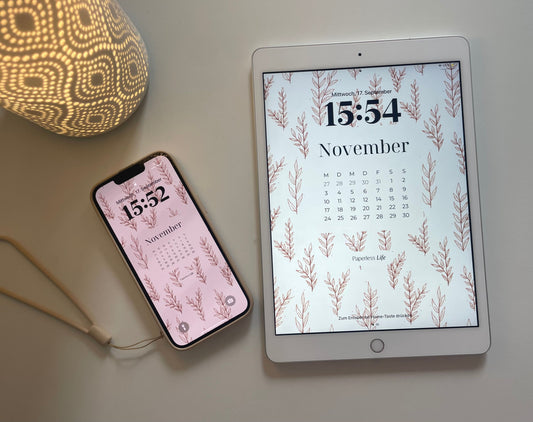Since choosing our name, we've been clear about our desire to drive the movement toward sustainable organization and planning. With Paperless Life, we want to embrace what digitalization makes possible: using less paper and digitizing many areas of life.
In addition to the positive effect of finally enjoying organizational processes, paper consumption is another important reason why I much prefer using a digital planner to pen and paper. From the very beginning, we didn't want to think "small" about Paperless Life. Surely it should be possible to switch from paper to digital in many areas of life? We wanted to find out for ourselves how practical digital planning is for everyday use. The beginnings were anything but easy. It took time to adapt new habits and switch completely to digital planning. But technology has advanced dramatically in recent years, and for me, writing in the future will be paperless, using digital devices.
In the early days of Paperless Life, I was still working on my thesis and, among other things, wrote about "The Future of Work." I was incredibly fascinated by the topic of digitalization and the question of how we will work and organize ourselves in the future. Digitalization is constantly advancing and impacting every area of our lives. I believe that paper has reached its limits in certain areas and should make way for more innovative and, above all, more sustainable alternatives.
Hey, Paperless Life!
In May 2020, my boyfriend and I were sitting in the kitchen of our attic apartment with a cold beer, philosophizing about what name to give our new project. Just a few weeks earlier, I had stumbled upon digital planning and was completely blown away by the little digital gadgets you use with your tablet. I have to say that at that time, I was still a very, very unstructured person who couldn't even begin to be enthusiastic about planning tools.
For the first time in my life, however, such a tool had my full attention. Shortly thereafter, I bought my first iPad and started creating my first digital planner. I was convinced that digital planning would have a lasting, positive impact on the way we organize ourselves in the future. That evening in our attic kitchen, we decided to create digital planners for everyday use and promote paperless planning under the name Paperless Life.
Why Paperless Life?
Even though "Paperless Life" translates to "paperless living," that doesn't mean everyone has to immediately banish paper from their lives. I'm all for freedom of choice—dog or cat, Nutella with or without butter, or a digital planner or paper. I just believe that we should fully utilize the existing possibilities of digitalization if it allows us to make a positive contribution to paper consumption. Digital planning gives me sustainable alternatives, and it has completely changed my thinking about paper consumption. Especially when it comes to organizational processes, paper consumption is unfortunately unnecessarily high. If I can contribute to saving paper with my planners, then that makes me happy.
With Paperless Life and our planners, we don't want to limit ourselves to a few areas of life. Instead, we want to demonstrate with a wide variety of planners that they offer many possible uses in everyday life . For example, if you already plan your workspace digitally, see if you can also store your recipes in a digital planner instead of an analog one. With my planners, I want to create a new awareness of paper usage that extends not just to one, but across many areas of life. Paperless work, paperless study, paperless writing, paperless cooking – I want to combine all of this with Paperless Life.
Sustainable digitalization
Paper consumption in Germany
I'll cover this topic in more detail in another blog post, but I think it's incredibly important to take a closer look at Germany's role in paper consumption. In a global comparison of paper consumption, Germany ranks fourth after China, the USA, and Japan (as of 2019). Germany consumed around 18.8 million tons of paper, cardboard, and carton (PPC) in 2019. Half of this paper consumption is used for packaging, followed by 6.8 million tons of graphic papers, such as writing paper and newsprint. Although paper production has a significant environmental impact, most paper ends up in the trash after one use. The relatively short lifespan is estimated to apply to 90% of paper .
"Almost every second industrially felled tree worldwide is processed into paper – newspapers, magazines, wrapping paper, packaging, kitchen towels, or toilet paper. This makes the paper industry a key industry when it comes to the future of our forests." (Source: https://www.wwf.de/themen-projekte/waelder/papierverbrauch/zahlen-und-fakten/)
In our globalized world, it's no longer easy to determine where the wood used by the paper industry and its paper products comes from. Illegal logging and overexploitation are a sad reality, and the global demand for paper continues to grow. While around 130 million tons of paper were produced worldwide in 1970, this figure had risen to 415 million tons in 2019. Even though Germany ranks fourth in the world for collecting and using waste paper, its per capita paper consumption is 227 kilograms per year, surpassed by only a few countries in the world (as of 2019).
Paperless home
With small adjustments in everyday life, everyone can make a difference. Newspaper readers can subscribe to the digital equivalent. They can avoid ads and free newspapers, use reusable gift wrapping solutions and reusable shopping bags. Unnecessary printing can be avoided by scanning their smartphones, to name just a few examples.
Something I would never have imagined before has become my everyday routine. I plan exclusively digitally, and I also do other areas of my life, like cooking, keeping a diary, writing shopping lists, etc., digitally. The transition wasn't easy, and it certainly won't happen overnight. It's a process that takes time and a lot of patience, but I'm sure that with enthusiasm for new technologies, persistence, and discipline, it will pay off.
The beginnings were rocky. Even after I decided to go digital, I still had the urge to write on paper, and my brain constantly told me that my iPad was inferior paper. I then rearranged my desk and banished all sticky notes, notepads, and anything paper-based from my desk. That worked quite well. I gradually came up with strategies for organizing my documents in GoodNotes so I could find my notes again. This gradually developed into a network of digital planners and cloud services. The process was then continually optimized, and digital planning gradually spread to other areas of my life.
Luckily, my brain has now also gotten around to it (the brain initially rejects anything new!), and the switch has completely changed my paper consumption. If I get a call and want to jot something down, I grab my iPad. I have no problem foregoing wrapping paper and handing my family and friends the "naked" present. At first, I received some questionable looks, but now most people have gotten used to it, or they have no other choice 😂 If we do something just because it's always been done that way, then goodnight! Then any change is nipped in the bud.
Allow changes
Technological changes are right and important because they can bring many advantages to us humans. For me, however , the key factor is how this change can be made more sustainable. What benefits some can be a disadvantage for others (nations, farmers, the environment, etc.). This makes it all the more important to take a holistic view of digitalization. Life cycle assessments can provide information about the life cycle of individual products with regard to their environmental impacts and energy balance, which makes them comparable. The worse the life cycle assessment, the greater the impact on the environment. I would also be interested in the life cycle assessment for a tablet so that I can compare a digital planner with a paper planner.
Digitalization will continue to creep into all areas of our lives, and I believe that we should adapt useful technologies to reduce the burden on other environmental areas. This is where digital planners come into play. Using them can simply save a huge amount of paper. Everyone can make their own contribution; I can raise awareness, but implementation starts at home.
Planning the future
Digitalization means change. These changes are clearly noticeable in our everyday lives. Time remains the most valuable resource available to us, and we should manage it well. Planning in the future will be paperless and more efficient. Whether it's a digital planner used on a tablet or other planning tools that fall under the term digital planning, sooner or later we will be doing most of our planning digitally. Whether we switch to digital planning of our own free will or only make the switch when encouraged to do so by our (work) environment is something everyone has to decide for themselves.
Our goals & projects
Wherever paper is used for planning or everyday purposes, I want to use Paperless Life to show people sustainable alternatives. If entire companies were to introduce their employees to this topic and show them the possibilities and opportunities for working with it, that would be a significant step in the right direction.
We plant trees with Planet Tree
In October 2021, we found a project called Planet Tree that we now support monthly. Planet Tree, in an official partnership with the state forests of Hesse and Mecklenburg-Western Pomerania, supports the reforestation of our local forests. Since Planet Tree's launch in October 2020, many thousands of trees have been planted, and with the support of private individuals and companies, the number is growing daily. I will introduce the project in more detail in my next blog post.
The transition from analog to digital takes time. But every major change begins with small, everyday actions.
Sources and further links:
www.verbraucherservice-bayern.de
www.foep.info/dokumente/
upload/46bd6_paper-protecting_forests_and_climate.pdf




